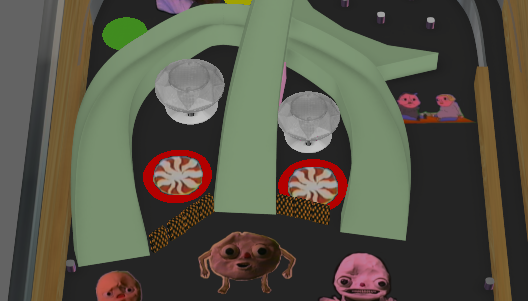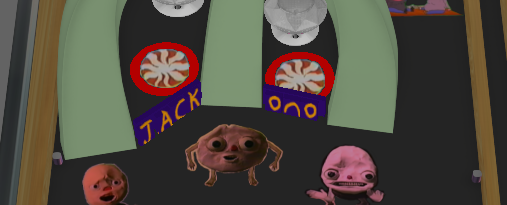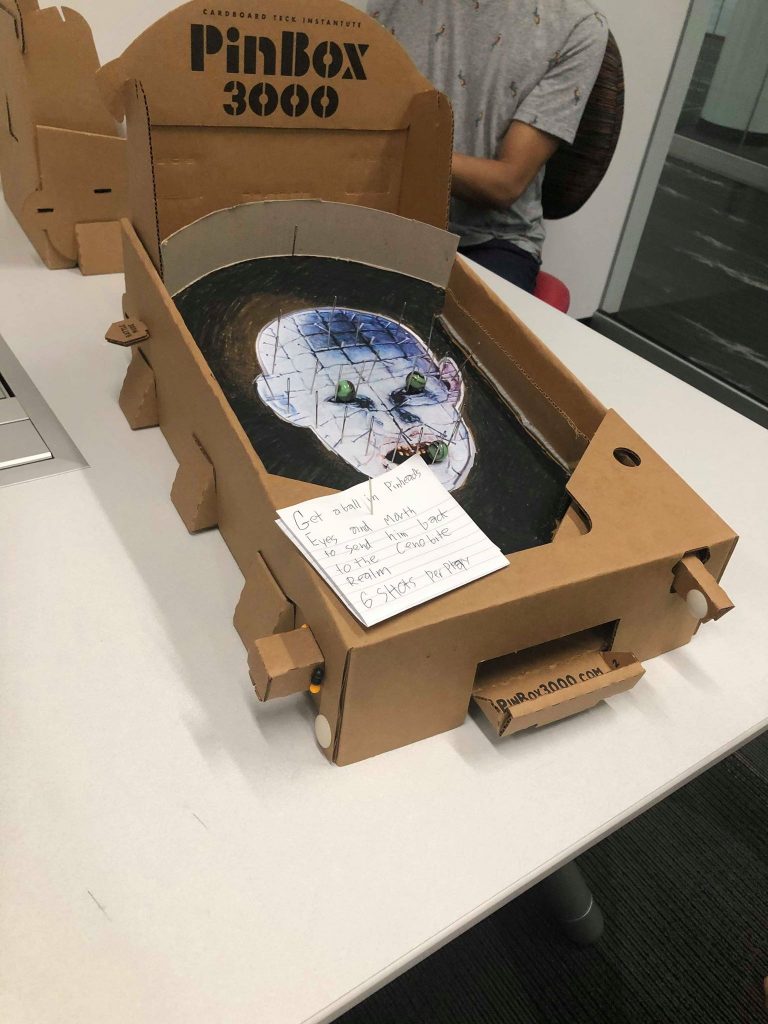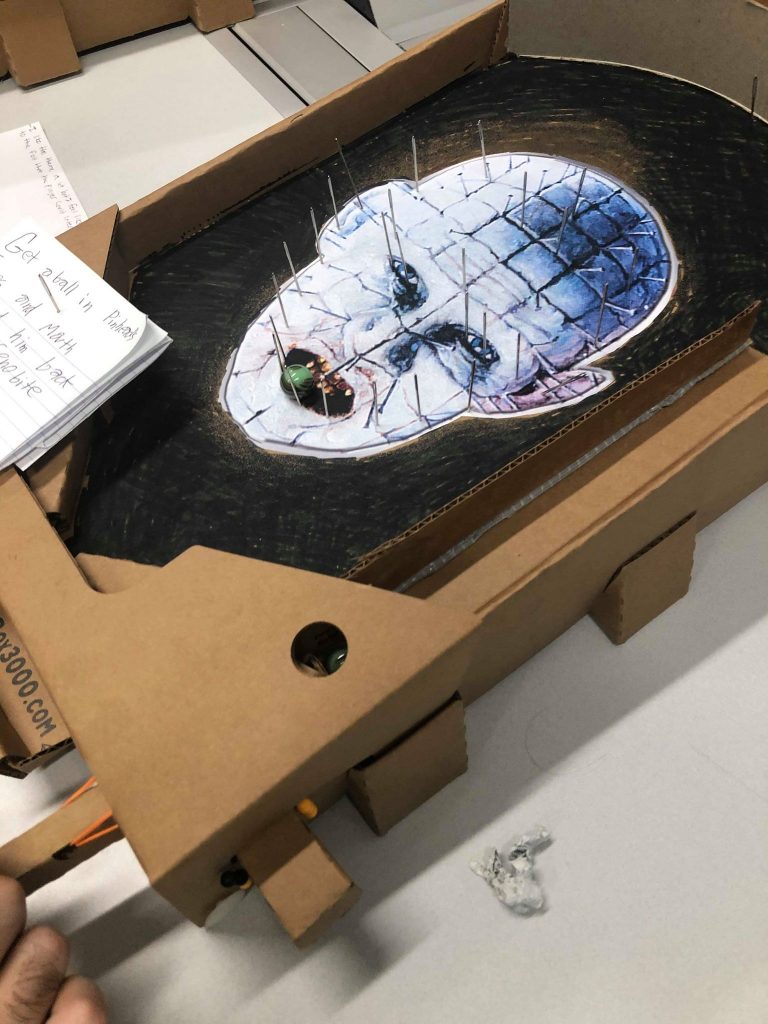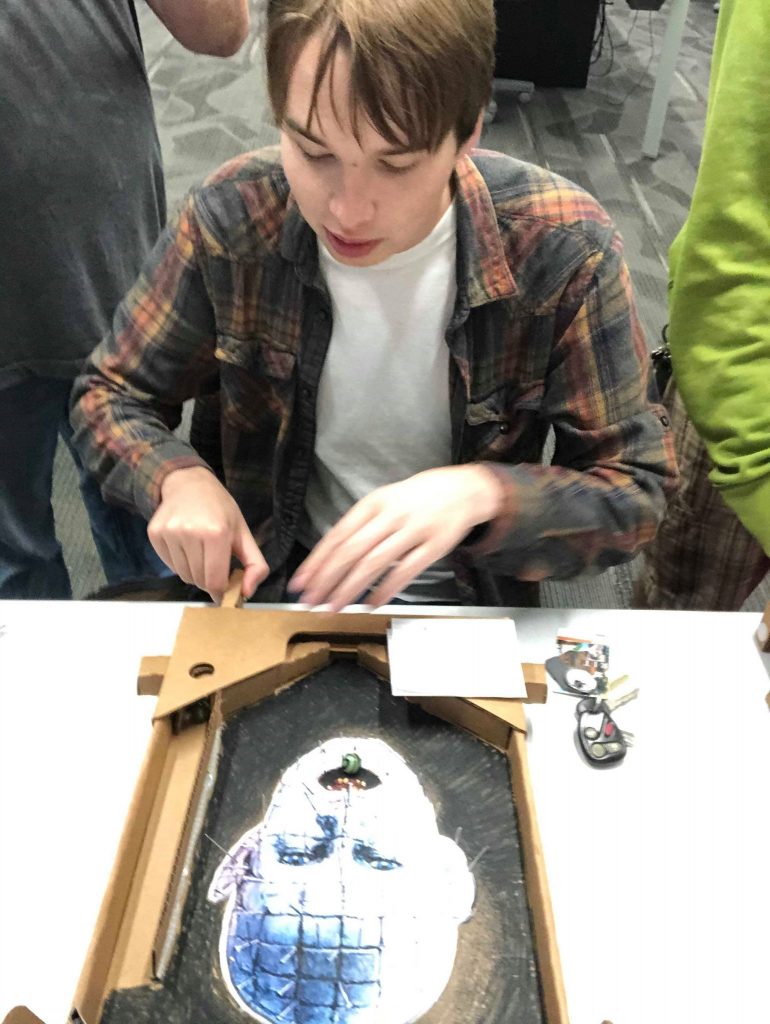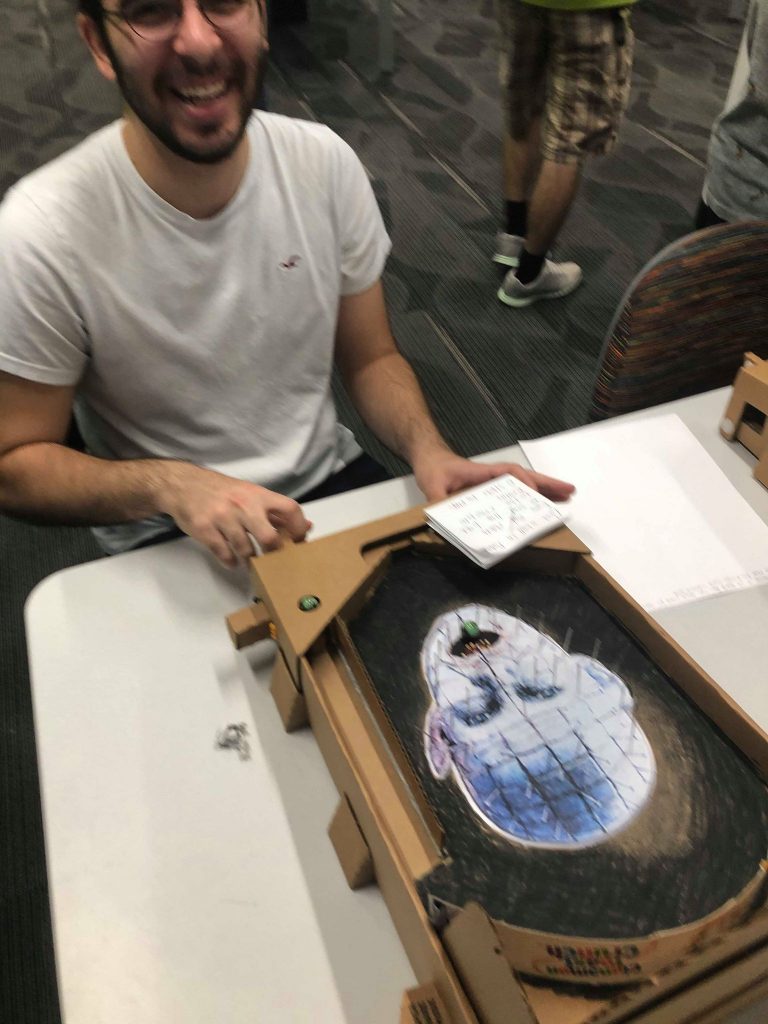Overall my experience at the strong went well. Everyone who played the game seemed to like it. I’d say my biggest takeaway from the experience was something George Gomez talked about with us. I think I needed to add more on my machine to draw players in. Unfortunately, my laptop’s internal speakers were not working that day, so I had the audio going to a pair of Bluetooth headphones. I realized once I was there that I should’ve brought an external speaker to let the game’s music attract players. I also think that while they were simpler, the pinboxes were more approachable and interesting to the average museum goer. While many of the visual pinball machines were better designed, the pinboxes had a nice feel to them that I think interested people. I think I should’ve brought one of my physical machines as well, to really attract more players. Overall, I think the playtest went well though and taught me a lot about getting a player’s attention
Author: cxa7619
Jack Stauber Pinball Playtest PostMortem
After playtesting my advanced machine in class, a few key issues popped up. I was grateful for these, because I knew exactly how to fix my machine for the strong playtest.
The first issue was with the drop targets. The way I had them allowed players to hit one or two and then get their ball stuck behind one that was still up. To remedy this, I put up an additional target behind them that doesn’t drop until all of the targets are down. This blocks players from getting into this area until they’ve hit all the targets. I also changed the textures on these targets. The original texture was too abstract and they don’t particularly read as targets. Now, the targets have a specific character on each one that makes them much clearer.
Another issue I had was with the music. There was a typo in my code which caused the final song not play. This was very jarring as it cut off the previous song to go to silence. I also noticed some funkiness with the ramps. The right ramp tended to act not as expected.
CJ’s Strong Choice Blog
For the strong museum presentation, I decided to bring my advanced visual pinball machine. This was because I was quite happy with my first visual pinball machine. I figured using what I could learn, I could make something even better. I liked my pinbox creations but I felt limited in my own ability to craft them. I felt like I didn’t have the skill to really iterate and enhance my physical machines in the given time.
Also, after attending the Maker Fair and being across from a Pinbox display, I saw how susceptible to damage they were after sustained play. This booth had around 10 machines and by the end of the day, more than half of them had been broken. I didn’t want to have to be repairing my machines on sight, so I knew I wanted to take one of my digital machines
Jack Stauber Pinball
I knew from the start of this class that I wanted to a pinball machine based on a musician at some point. As the class went on I realized it made the most sense to wait until we were doing digital pinball machines to follow through on this. As I thought more and more about it, I realized Jack Stauber would be a great theme for a machine. I think his unique, low-fi pop style would be a great fit for a pinball machine. In addition, he has a unique visual style that gives tons of visual inspiration for the machine. He has several distinct visual styles he uses in his various music videos and I think these could be used in different areas on the playfield.
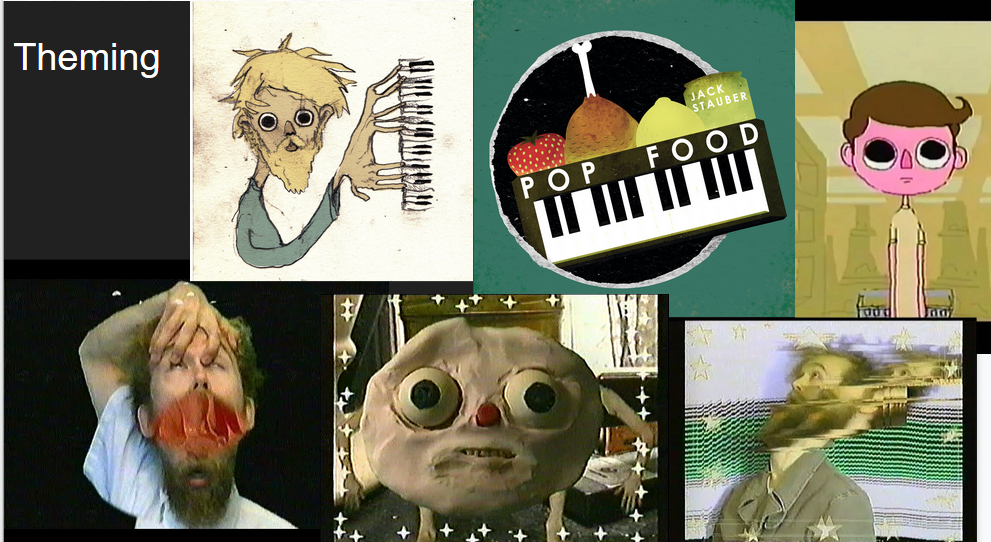
Mechanically, I want to take the ramp-centric design of Basic Visual Pinball table, and add a few more ramps, while polishing the game play. I want to improve the scoreboard system, so it actually keeps track of high-scores. I want to have actual game starting and ending logic, so the player isn’t using the honor system to be limited to 3 balls. I want to introduce goals that reward the player with multi-ball. I think a smaller goal like that (aside from just getting a high-score) would be more rewarding and engaging for the player.
My main goal with this machine would be to have the song change depending on the game. I want different events (Ball draining, multi-ball activated, score barriers) to trigger changing to a different song. Jack Stauber has an excellent discography and I think this would be a fun way to implement that in the machine.
Jet Set Radio VP Basic Post Mortem
So after having people play test my level, I realized I had several spots on my machine where the ball could get stuck. This is was the biggest problem with my machine. Another problem with the machine was that the kicker’s on the out-lanes were always active. This was originally done in response to how frustrating it was when the ball went there so often. However, this created a new problem. It became way too easy to keep the ball in play. I got a suggestion from Jimmy, that I should keep the kickers but make them relatively easy to activate. This is definitely the solution, as from there I could adjust the numbers on activation until I got a difficulty I was happy with.

Another problem I noticed with this machine was the bumpers. The placement and power of them could lead to the ball being in the bumper zone for an awkwardly long time. If I were to update this machine, that is definitely something I would change
After the play test, I think the board is somewhat weak visually. my original intention was for the ramps to look as though they’d been filled with graffiti a few times over, but the texture did not convey this well. A lot of people asked me what the ramps were supposed to be at first. They understood after explanation, but them asking in the first place illustrates the lack of clarity. I also didn’t have time to theme some ancillary aspects of the machine like the wood exterior, the plunger, the flippers, or the kickers. I also would have liked to add more lights to my machine. I think for my next machine, I will use this as a basis to be able to further polish it.
PLayfield art from Ross Burt (https://www.gamesradar.com/why-i-love-jet-set-radios-skates/)
Graffiti texture Ramp Textures: (https://pxhere.com/en/photo/1418330)
Jet Set Radio Visual Pinball Pitch
For my first visual pinball project, I wanted something simple that I would be able to implement sound effects into effectively. I decided to theme my machine off of the Dreamcast Skating game, Jet Set Radio. I think the game has a very unique sonic Identity that would be very fitting for a pinball machine. The game also has a very unique visual style, with an early 90s Japanese street wear influence and a graffiti-inspired art style. The game has a lot of vibrant colors that I thought would look nice. This is what led me to choose JSR for my theming.
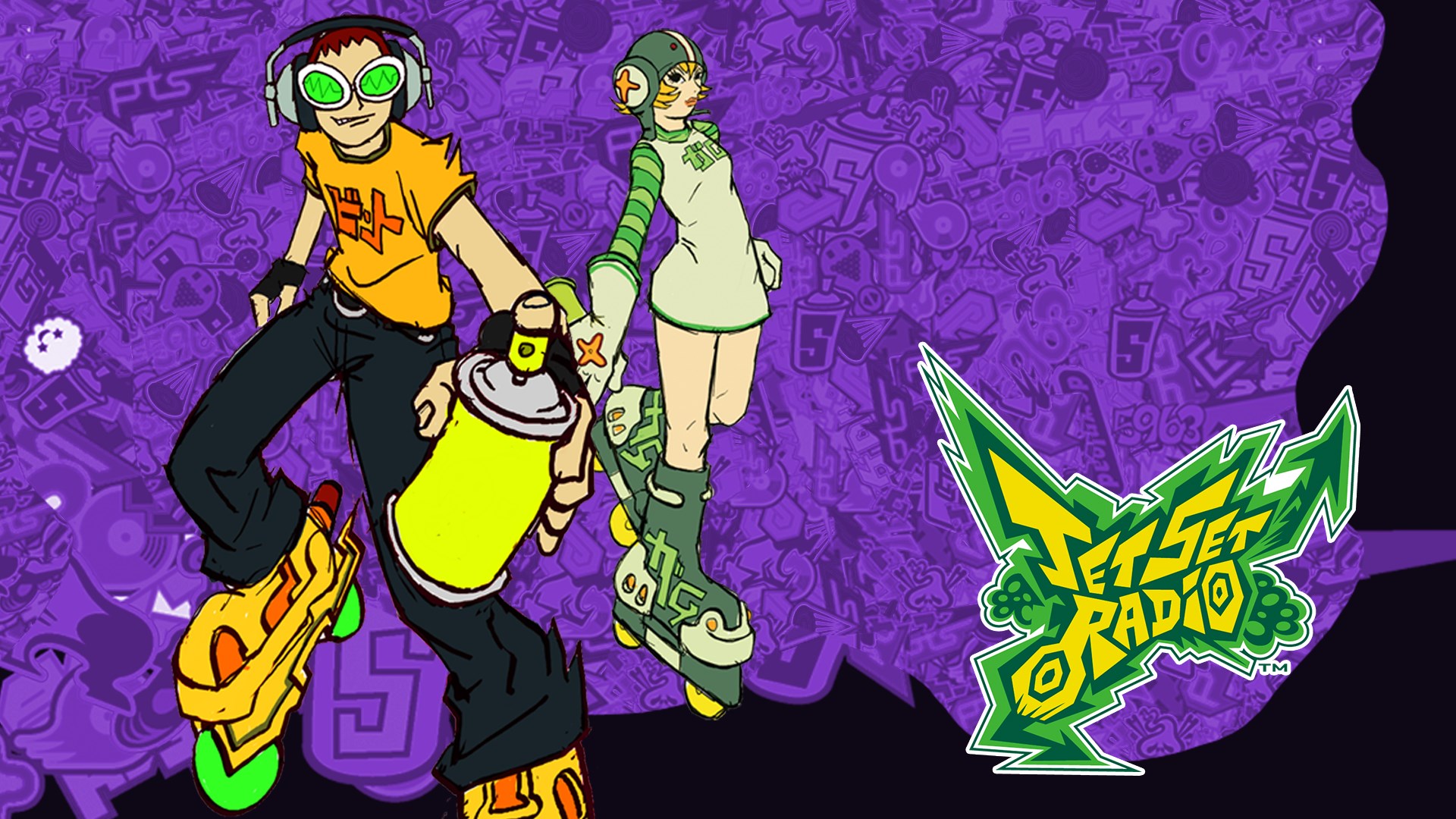
For my actual playfield, I wanted to heavily include ramps. For me, I find ramps to be one of my favorite playfield-elements in pinball machines. I think they’re very satisfying so I tried to emphasize a fun ramp loop in my machine. I also tried to implement bumpers to fill out the machine.
Green circles=Rollover targets
Squares=Dropdown targets
Now that we’re using visual pinball, I want to make my machine have a focus on scoring. In a cardboard machine, having to count the score yourself is very tedious so I tried to use other sorts of goals/objectives in my previous machines. Now that scoring can be automated, I want my machine to have a fun and effective scoring system, like many classic pinball machines have. My stretch goal for this machine is to implement some sort of multi-ball for my machine, but this will depend on how much time I have.
Hotline Miami Post-Mortem
After having play tested my Hotline Miami machine, it was very apparent what the strengths and weaknesses were of the machine. The strengths were the visual appeal. I got a lot of compliments on the looks of the machine and was very happy with how it turned out. The EL wire went a long way in giving the machine a unique look and helped capture the 80’s neon aesthetic of the game Hotline Miami. The third flipper was very well received also. People seemed to think it felt very good, which I was happy to hear. I spent a lot of time working on the feel of that flipper until it was just right. The only downside I had with this flipper was that my implementation required that the extra flipper be directly above the left flipper to function properly. This meant I had to sacrifice a lot of playfield space to get this flipper working.
Most of the criticism I got on this machine was with the implementation of certain things. The ball had a tendency to get stuck on the EL wire that lined through the ball return. The ball also could get caught on one masks (the one below the third flipper.) I think I would have redesigned the playfield to more accommodate this space if I could redo the project. It was also much more difficult to get the mask on the top left than I had originally intended. Also the EL wire looks much better in dim or dark lighting than in a well lit room.
Assets for the machine from
Playfield Art from Hotline Miami fan-art by Anu Patten (https://www.artstation.com/artwork/zAQPqZ)
Masks art taken from Hotline Miami game (specifically this rip of the games assets: https://www.artstation.com/artwork/zAQPqZ )
Beard character Art taken from Hotline Miami (specifically, the rip of his asset available on the Hotline Miami Wiki: https://hotlinemiami.fandom.com/wiki/Beard)
Dragon Ball Z Post Mortem

After the play test session, the problems with our machine became very clear. The most obvious of which was the areas where the ball would get stuck. Despite us trying to iron out all of these spots in the building process, balls still got stuck under the ramps and on the side windows between the two playfields. These are easy fixes and we plan to touch them up.

Another big issue is with this battlebox was our drop mechanism. This was done to have the game start with an 8-ball multi-ball for each player. This was so the game would start incredibly hectic and fast-paced and over the course of each round the game would slowly become more deliberate and concentrated; however, in many of our playtests, the drop mechanism dropped a lot of the balls right down the middle at the start of each round, draining at least 2-3 balls on each side immediately. This was frustrating and confusing for a lot of playtesters. We think the fix for this is to wall in the sides and put the balls there, so that balls don’t drain immediately. Another problem is that balls had a tendency to go flying out of the machine. We believe this was caused by the ramps connecting the machines not being an even surface. This could be fixed with a simple taping over the ramp surface.
One suggestion made by a playtester (Shouts out to Jimmy) on how to improve the game was to introduce different balls, some of which would be worth more points. This would add an extra level of depth to the game, because players would have to be more considerate of that ball worth more points. We liked this idea quite a bit as it keeps the frantic energy of the machine while adding a new and interesting layer of complexity to the game play.
Our machine had many flaws, but I believe most of these are easy fixes. The overall concept and design of our machine seems to have been successful. During playtests, players were very excited and engaged during the game.
-Christian Axisa & Chris Commisso
Dragon Ball Z Battle Mode Pinball Design
When I first heard we were doing a battle mode pinbox, my first thought was to make one themed around a fighting game. I love the rivalries that exist in a lot of these games (Ryu & Ken, Scorpion & Sub-zero, etc). However, as I thought about potential fighting games, none of them stood out to me as a particularly interesting theme for Pinball, until I consider Dragon Ball FighterZ. I’ve always loved the energetic, exaggerated, and fast paced fighting of the Dragon Ball franchise, and thought this could work excellent for battle pinball machine. I thought about the tropes of the show, and was drawn to the quick multi-punch shuffles that often happen. I thought this could be well represented by having a large amount of balls in play at once. This would also help capture the eclectic, fast-paced nature of these fights.

When I first conceived using a large amount of multi-ball, I thought back to Hyperball, which i played at the strong. Hyperball features hundred of pinballs that the player can shoot in any direction they aim. The sound and feel all of the balls being constantly shot felt great, and helped give the game a sense of speed and intensity. This gave me confidence that the idea could work for battle pinball.
This machine is going to have some sort of levy system, that will drop all 16 balls for both players at the same time. Players will keep going until all the balls have been drained. Once this happens, players will count the balls drained on their side, and whoever has less balls drained will be the winner of that round. Best 2 out of 3 rounds wins the game.
My initial design sketch has a somewhat barren playfield. I tried adding some holes to the design to help with that, but I’m not particularly pleased with this though. I want to keep the playfield generally very simple. I think a complicated playfield with this many balls will just be anxiety inducing instead of simple fun. That being said, I think right now it’s still a little too barren. I think some obstacles (cardboard walls) that lead balls to drain to the center will be a better move. I’m also considering moving the ball-drop-levy system to the center of the the two pinboxes, so balls will start falling down. I’m not exactly sure how, but I think it’d also be a good idea to have an odd number of balls so that way ties will not be an issue. Perhaps a locked ball staring in the center ramp? Only Iteration will tell.
Hellraiser Post Mortem
I found this machine was somewhat tedious to build. once I had the basic Pinbox set up, I spent most of the time slightly moving pins and play testing. A lot of the time was me trying to collect data and probability on how many tries it would take to successfully make the marble into a spot. Overall though, I thought it was a fun experience to build this machine. It was very satisfying to have a finished machine on Tuesday, and I think I’d like to spruce up my machine based on feedback I got on Tuesday.
I received a lot of good feedback on this machine during the playtest. People generally liked how I included the theme in the machine, but a few people suggested ways I could include more from the Hellraiser franchise (ie; using the cube from Hellraiser one as the drain, other cenobites on the back and sided boards etc). The piece of feedback I received the most was the pin placement around the eyes. Basically, it’s very hard to get the ball there and there’s a few pins around the eyes that look like they’re close enough to catch the ball, but they’re just a little bit longer. This was very frustrating for a lot of people, so after the playtest I changed the pins layout to be close enough to catch the ball.
Another piece of feedback I got is that some players wanted for their to be more for players to interact with on the playfield. I think adding some additional obstacle/mechanic other than the pins would help with playability and make the game more interesting. It’d be a challenge to do this while keeping the current theming, but I think it’d be worth finding a solution. I think that’s the thing I’d change if I were to make this machine again. While I like the simplicity of just the pins, I found the other Bagatelle machines with more features/rules/mechanics to be incredibly fun to play and I kept wanting to return to.
The only source I used was the 1987 Hellraiser poster which is where I got the pinhead art from.

